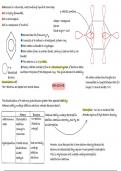Summary
Benzene Chemistry Summary - Unit A2 1 - Periodic Trends and Further Organic, Physical and Inorganic Chemistry
- Course
- Institution
Summary of benzene's shape, bonding, delocalisation, hydrogenation, reaction with bromine water vs alkenes, bond angles and more shown in an organised and logical 2-page explanation.
[Show more]



